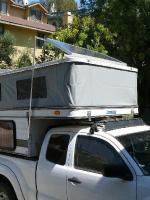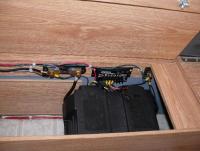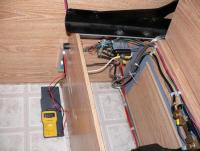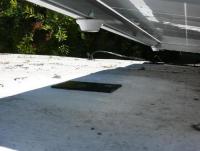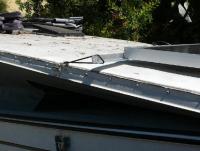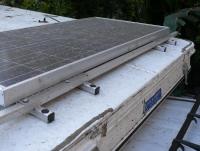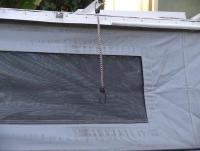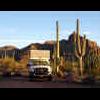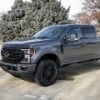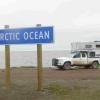
Gone Solar!
#1

Posted 01 July 2008 - 02:02 AM
We got a 120W Mitsubishi panel and a MorningStar SS-10L-12 charge controller from Alter Systems. There are other good vendors out there, but what is important is that you get a reasonably efficient PV panel (12% or better) and an MPPT (Maximum Power Point Tracking) charge controller. The MPPT type charge controller optimizes your power under less than optimal conditions (ie, when it's not high noon in SoCal). It's well worth the extra bucks, since it can increase the power out of the PV panel by 25% at lower light levels. You don't need an "RV kit", just the PV panel and the charge controller. Check with the vendor to make sure the charge controller is appropriate for the PV panel (current rating, etc.)
You pick your PV panel wattage based on usage. Take the current output of the PV panel (6.7A for our 120W PV panel) and multiply by 8. You get more in the summer and less in the winter, but this is a good working number for 3/4 of the year. Now, for FWC, figure 4 amps each for the roof fan and heater fans. If you use LEDs for lighting (see http://www.wanderthe...read.php?t=1070) they hardly count (.3A). For incandescent, 1.5A per bulb or 6A if all interior lights are on. For us, we add two laptops at 5A each. Now multiply the current for each device times the hours you expect to use it in one day in summer and one day in winter and take the larger of the two results. This came to about 58 amps/day for us. Our PV panel, at 6.7A for 8 hours, comes to 53 amps/day. (Ok, we also have a 1KW Yamaha generator (similar specs to the 1KW Honda but cheaper) so if we mis-calculated or for winter time in the Pacific Northwest coast.)
We mounted the panel to the front bar of the FWC roof rack with two 1 foot stainless steel piano hinges. If you already have the PV Panel connector on the roof (I think FWC does this standard, now) you need a molded two-connector automotive plug (see http://www.delcity.n...ageitem=1&new=y for picture). Make sure that the exposed connector is the negative output from the PV so that when you unplug it, it won't short to the chassis. This should also be the black wire, which, on the Eagle, is under the wooden cover between the front of the camper and the front of the kitchen unit on the drivers side. But buzz the wires it out just to make sure!
Connect the PV panel to the charge controller and the battery to the charge controller. It is best to place the charge controller near the battery so that the voltage drop from the charge controller to the battery is minimized. Also, place a fuse on the positive side for both the battery connection and the PV panel connection. This is to protect both the charge controller and the PV panel. Since it was a 10A charge controller, we chose 10A fuses. The charge controller basically takes the output of the PV panel, which can range from 20V to 12V and 6.7A to a lot less and optimizes it to 12.6V (or so) and whatever current is being produced. We did not connect any load to the charge controller because the electric distribution panel is on the other side of the camper and the wiring would have gotten quite complicated with the converter and alternator connections. The advantage of connecting the load is that the charge controller will disconnect the battery (which means the "loads" will be turned off) when the battery is too low, thus protecting the battery from being over discharged (and potentially killed). If you install an inverter (12V DC to 115V AC), you may want to connect it to the load connections on the charge controller.
Having killed one battery by discharging it completely, I intended in the future to install a battery cut-off switch. Also, we used 10 gauge instead of 12 gauge braided wire (and braided wire is so much easier to route than single strand) to minimize voltage drop.
An aside about voltage drop for the non electricians and engineers. The goal is to get as much power to the consumer devices in the system as possible. Wire size is like a hose diameter and current is like the water. The narrower the hose, the more energy (voltage) it takes to push the same amount of water (current) through the hose. That means that the narrower the hose, the less energy there is at the device. In electrical terms, the resistance of the wire is part of the load and the wire and the load act as a three resistance voltage divider. Since current stays the same and since the power at the device is current x voltage, the higher the voltage at the device the more power. The $1 or so difference in wire cost buys about 1 watt of PV panel power. The difference between a 120W PV panel and a 123 PV panel is about $40.
To support the PV panel, we glued rubber pads (adhesive cement) to the roof and attached rubber feet to the PV panel. The hope is that either can be replaced as they wear, without ever damaging the roof or the panel.
Tying down the panel during travel is not a final solution. The bungee cord is a bit minimal. I'm looking for rubber loops with twin hooks, but other suggestions are most welcome. The loop attached to the roof latch are just figure eight loops, with one end under the screw.
I also put shunts on the negative side of the battery and the PV panel (0.1 Ohm) and attached sense lines from them and the positive side of the battery and PV panel to test probe connectors. A $10 Radio Shack DMM lets me see the voltages and currents for both the battery and the PV panel - far cheaper (and a bit less battery draw) than the optional readouts for the charge controller and the battery (OK, the shunts were free, otherwise, buy the readout LCDs).
#2

Posted 01 July 2008 - 02:12 AM
#3

Posted 01 July 2008 - 10:16 PM
#4

Posted 03 July 2008 - 01:54 AM
Craig K6JGV_________________________ 2004 2500 CTD 4X4 FWC HAWK 1960 CJ5
#5

Posted 03 July 2008 - 03:56 PM
I suggest that others considering solar think carefully about whether or not to make the panel tiltable. Fastening the panel flat is simple and secure. Tiltability adds more complexity to the install and may not be worth it depending on where you live and camp. Here is a link to help you decide: http://quantum-sci.c.../insolation.php
Former Grandby owner
#6

Posted 19 April 2009 - 03:54 PM
I've added a photo showing the front hinges. The half of the hinge that is not visible is mounted to the back of the solar panel. The sides of of the solar panel are channel aluminum, with about a 3/4 inch lip to which the hinges are bolted with three bolts. When I drilled the holes for these bolts, I placed a block of wood in the channel slot so that when the drill broke through it hit the wood instead of continuing on into the back of the photovoltaic matrix. I don't remember the reason for not mounting the hinge to the side of the solar panel, but when mounting to the back, make sure there is about 1/16" between the edge of the panel and the center of the hinge so that the panel will swing freely. As I mounted the panel, it will not swing past about 45 degrees, but then, we don't intend to go so far north (or south) that greater angles would be needed.
One other item to point out on the mounting is to position the rubber pads over the roof ribs.
The rubber pads have held just fine and they and the rubber door stops show almost no wear.
We found that the small bungee was not adequate for rough roads, so we now have a bungee on each side that hooks to the jack plate for travel. We also found that high winds (30mph and above) can bounce the panel, making for a less than ideal sleep, so we still use the small bungee when camped if there will be high winds.
Incidentally, the pictures also show part of our forward hydraulic system. We found that the doors of the Tacoma are precisely aligned with the drip from the Eagle roof. In any kind of rain, opening a window or door would bring a stream of water into the cab. The bead of (formerly) white silicone caulk and the plastic gutter strip have pretty much taken care of the problem.
2015 Fleet on 2019 Ranger
#7

Posted 20 April 2009 - 01:55 AM
#8

Posted 20 April 2009 - 06:46 PM
Did you run across any portable installations around the same wattage you used when you were doing your research?
I don't know if it's practical or not, but I'd like to be able to transfer solar from camper to boat to cabin using the same panel, controller, etc. just hooking up to wing nut connectors at the battery terminal.
#9

Posted 20 April 2009 - 08:45 PM
I don't know if it's practical or not, but I'd like to be able to transfer solar from camper to boat to cabin using the same panel, controller, etc. just hooking up to wing nut connectors at the battery terminal.
Just one set of connections is probably a bit of wishful thinking if you are actually installing the wiring to run though the camper instead of setting up a portable panel when you arrive at camp. However with some additionally strategically placed quick disconnects I'd think you could disconnect the panel as a whole and the controller as a whole (leaving the wiring through the camper and such), then just have the same wiring set up where ever you want to reconnect.
2022 F350 7.3L; family trailer at the moment and some aluminum stuck together to eventually form another truck camper
#10

Posted 20 April 2009 - 10:22 PM
There were one or two, but the folks simply didn't attach the solar panel to anything - just some legs to prop it up on the ground. At $750 or so, I didn't want a panel that could walk away so easily.
The panel is the big ticket item and has a single 2-wire connection. The Morningstar 10A MPPT charge controller comes in at about $50 and it is connected to 6 wires. Consider installing a charge controller in each of the locations and just moving the panel around. There are just 4 bolts that hold the panel to the FWC.
2015 Fleet on 2019 Ranger
1 user(s) are reading this topic
0 members, 1 guests, 0 anonymous users



